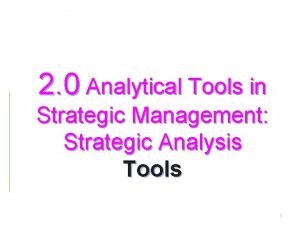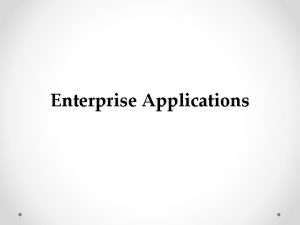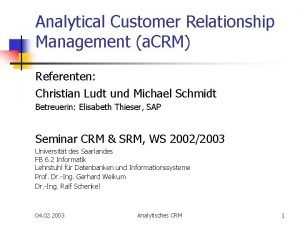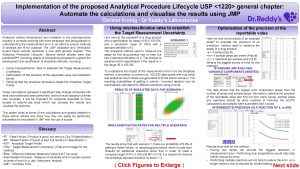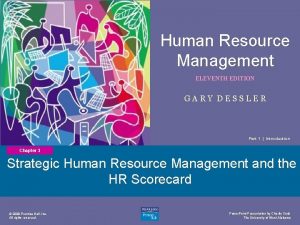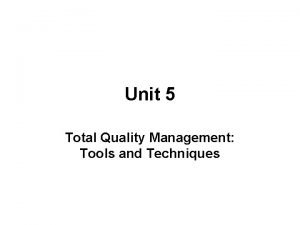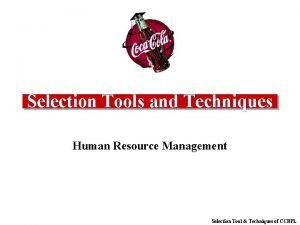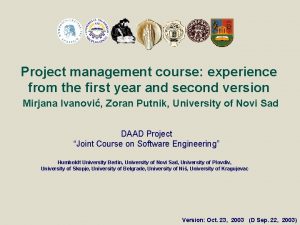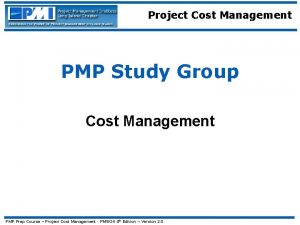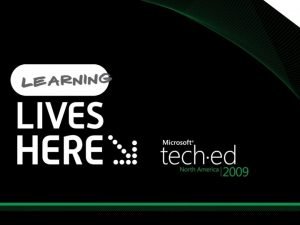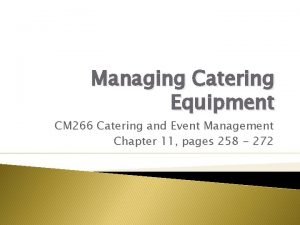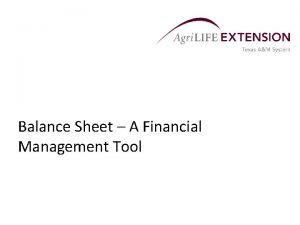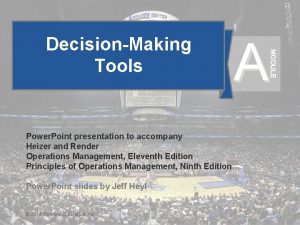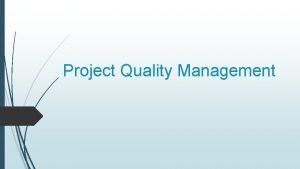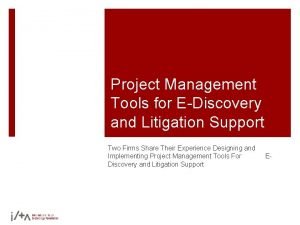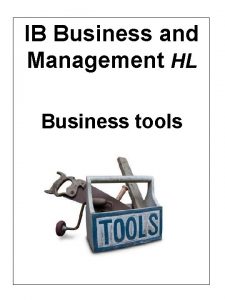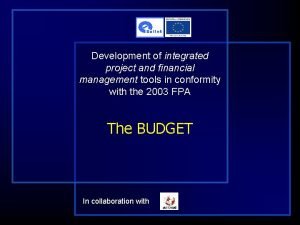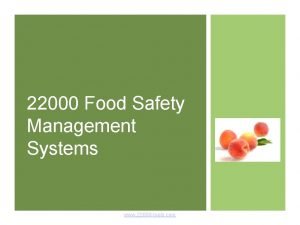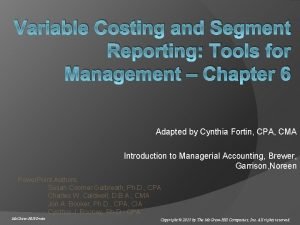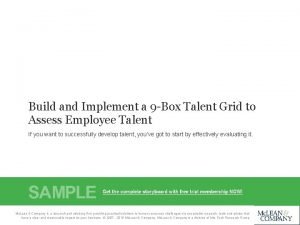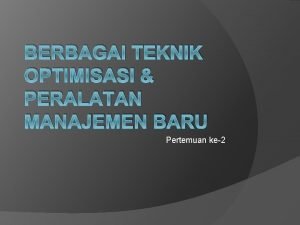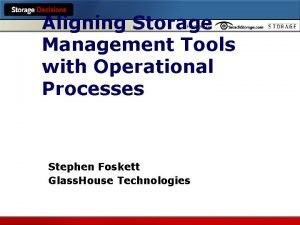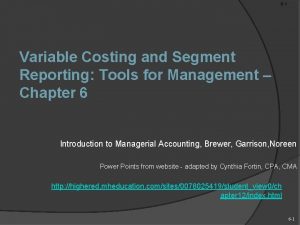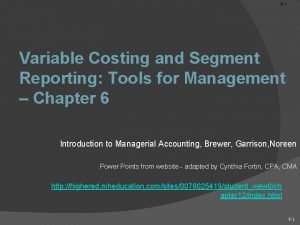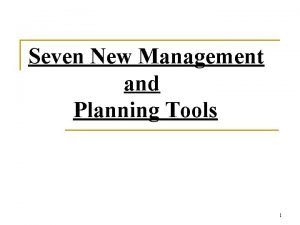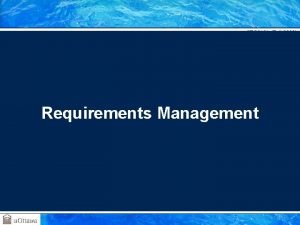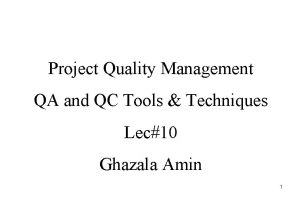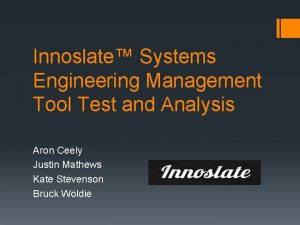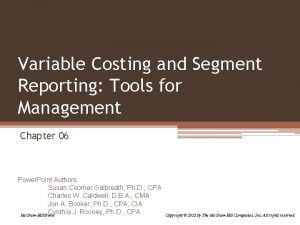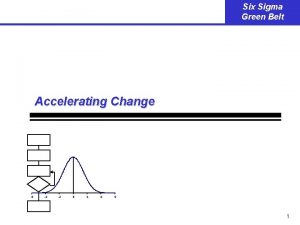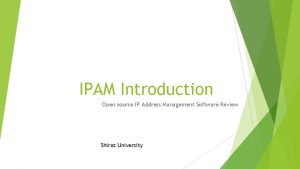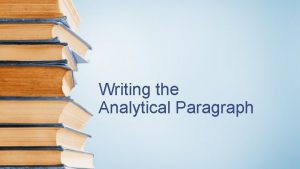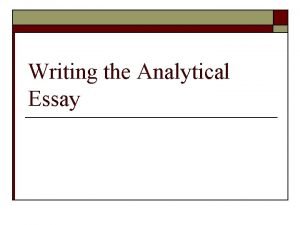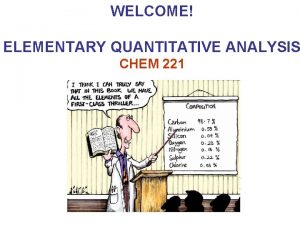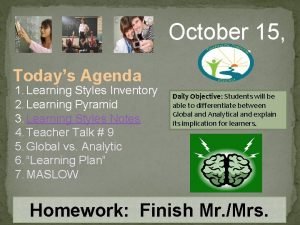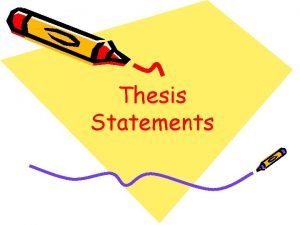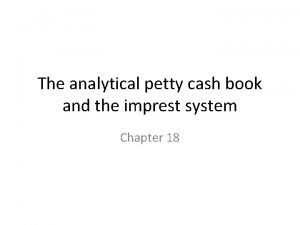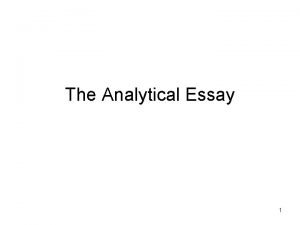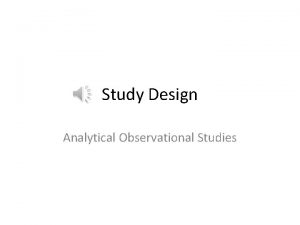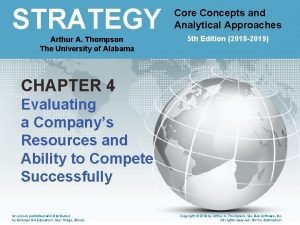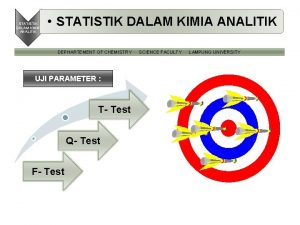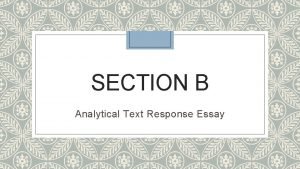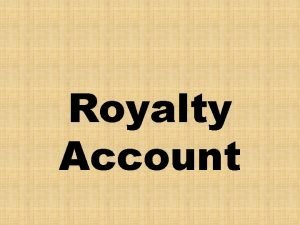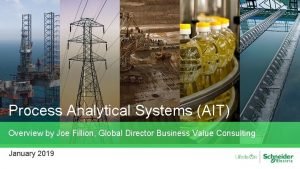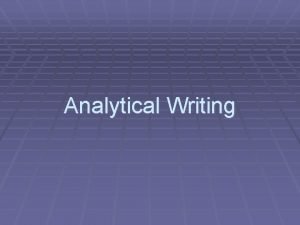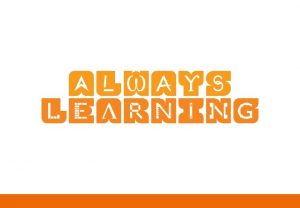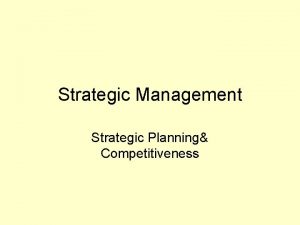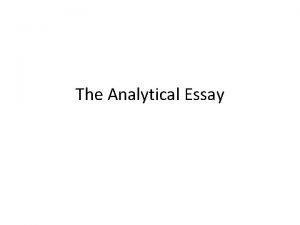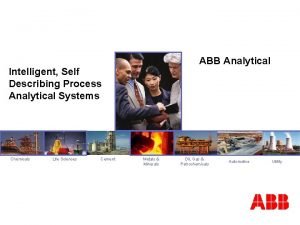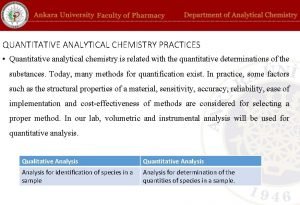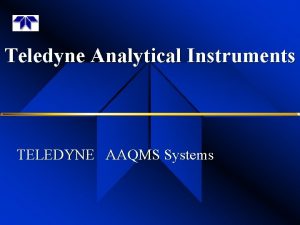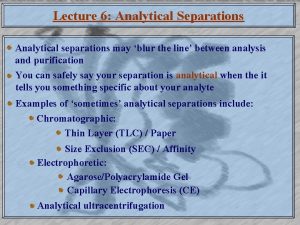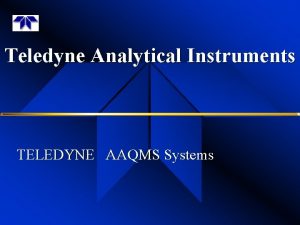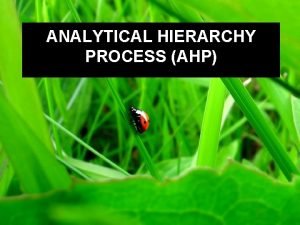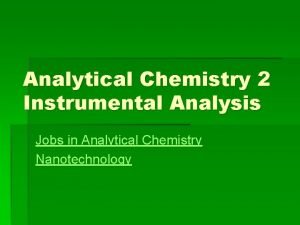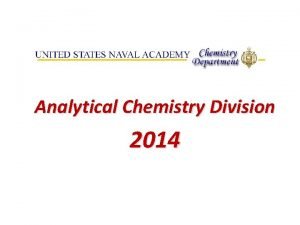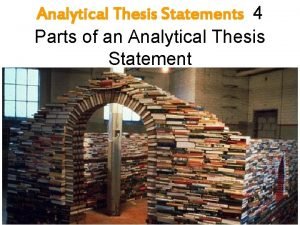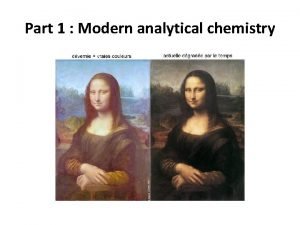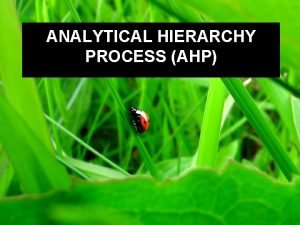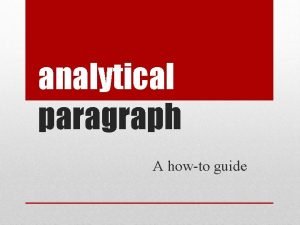2 0 Analytical Tools in Strategic Management Strategic





























































- Slides: 61

2. 0 Analytical Tools in Strategic Management: Strategic Analysis Tools 1

Preamble: Framework for SM • Our discussions are based on a Framework for strategic management proposed by Johnson & Scholes, 1993 and has three main elements: 1. Strategic analysis (environment, culture and stakeholder analysis, and resources and strategic capability) – to understand the strategic situation 2. Strategic choice (generation of strategic options, evaluation of options and selection of strategy) – to form the strategies 3. Strategy implementation (planning & allocating resource, organizational structure and design, managing strategic change) – to implement the strategies (tactical) 2

• Notes: – The above elements not executed sequentially, hence model is not linear – Strategic Analysis +Strategic choice = strategic planning – SM = S Planning + Strategic Implementation The Above is called design school of strategy (strategy as a planning activity) is not necessarily right (compare this school with pattern school which provides linear flow) – However it provides a framework for discussion of SM • Role of tools is not necessarily to help develop strategy only, but also to provide a basis for communication, discussion and sense-making 3

RELATIONSHIP OF STRATEGIC MGT ELEMENTS Environme nt Expectations, objectives, culture Resources STRATEGIC ANALYSIS Generation of options Resource planning STRATEGIC CHOICE Evaluation of Options Selection of Strategy STRATEGY IMPLEMENTATI ON Organizational Structure People and Systems 4

Strategic Analysis Tools 5

2. 1 Introduction • Strategic Analysis aims to form a picture • of the influences playing upon the organization inorder to be informed of the strategic choice elements of the overall strategic management process It is concerned with the following: – Organizational strategic position – Environmental conditions – Organization strengths and weaknesses – Effects of all the above on organization stakeholders 6

• SA involves understanding three factors: – Environment • the world in which the organization exists • need to understand the impact of the environment upon the organization – Values and objectives • these influence the perceived acceptability (to each stakeholder group) of candidate strategies • it is through these perceptions that other influences are interpreted esp. power differentials – Resources • they provide the internal influences upon strategy choice 7

2. 2. Environmental Analysis 8

2. 2. 1 Environmental Analysis • Purpose – to increase the quality of the strategic decision making by considering a range of relevant features well before the need to make an irrevocable decision • Threats and opportunities – the strategy is directed at exploiting the environmental opportunities and to blocking environmental threats in a way that is consistent with internal capabilities (Porter’s concept of “environmental fit” that allows the organization to maximise its competitive position) 9

• Success of E. A. largely depends on the • complexity of the environment A possible process of environmental analysis and tools to use: – Audit the environmental influences – Assess the nature of the environment to judge whether it is simple or complex – Identify the key environmental factors using porter’s five forces model – Identify the competitive position using a life cycle analysis – Identify the threats and opportunities using the SWOT analysis 10

2. 2. 2 Nature of the Environment • An organization’s environment comprises all the • events, issues and facts which will influence it’s performance but over which it has little influence Societal environment – conditions that have a broad rather than direct impact upon the organization – conditions represent the world within which the organization operates e. g. demographic, legal, political factors, social pressures etc • Task environment – that which has major and direct impact upon the organization and it’s strategic planning process 11

2. 2. 3 Model of Environment Societal Environment Economic forces Task Environment Government Demand Internal Environment Structure, Cultural web, Resources Technology Socio-cultural forces Political-Legal forces Market Structure Technological forces 12

Key Dimensions of Societal Environment Socialcultural Lifestyle changes Career expectations Population growth rate Pop. age distribution Life expectancies Economic Technological GNP trends Spending on R&D Interest rates Focus of tech. efforts Inflation rates New products Unemploy. New technoment levels logies Productivity Price improvements controls Birth rates Energy availability Political-legal Anti-competition regulation Tax laws Special incentives Foreign trade regulations Environmental protection laws via automation 13

Key Dimensions of Task Environment Demand Market Structure Size & No. /size growth of distribution of existing competitors & market suppliers No. /size Barriers to distribution entry or exit to of customers market Technology Government Level of technology and likely change Impact of particular legislation on the industry Cost structure including economies of scale Role of gvt as supplier, competitor or customer Physical distribution channels Dependence upon particular raw materials or labour Nature of competition in market Product characteristics 14

• 2. 2. 4 Significance of Environmental Analysis • Strategic analysis involves assessing the effects of possible changes in the environment. It involves: – Considering how the societal, task and/or internal environment factors may change – Assessing the strategic implications of such change for the organization 15

2. 2. 5 Porter’s Five Forces Model It models the competitive world of an organization and the forces that play upon it. Threat of new entrants Bargaining power of suppliers Rivalry amongst existing competitors Bargaining power of buyers Threat of substitute products or services 16

• The current competitive position of the • • • organization will be the aggregate of the 5 forces The net power of the 5 forces needs to be judged Strategy is to concentrate attention upon those most significant - either to exploit a powerful position or to protect from a weak one Forces and their contributory factors are outlined below ((a) – (e)): 17

(a) Rivalry between competitors Rivalry will be intense if (converse for low rivalry): • • Industry growth is static or in decline Fixed or storage costs are high - the volume of sales must be maintained Low product differences, brand identity and switching costs for customers Large number of organizations of similar size Intermittent over-capacity or supply High diversity of competitors Corporate stakes - single-product industries High exit barriers 18

(b) Threat of new entrants The following will act as entry barriers: • Government policy, esp. wrt acquiring licenses to • • operate Threat of retaliation Existing firms have lower costs than new entrants Difficulties in access to distribution channels High switching costs for buyers Large economies of scale for competitive pricing High product differentiation and brand loyalty High capital requirements 19

(c) Threat of substitute products Threat is high if (and low for converse): • Relatively low price and high performance of • • substitute products Low switching costs for customers Buyers’ high propensity to substitute products, e. g. militant or dissatisfied buyers 20

(d) The power of buyers • Price sensitivity - A number of factors can reduce price sensitivity: – – brand loyalty and differentiation the impact of the product on their product customer's own profitability decision makers' incentives (e. g. quality, etc). • Bargaining leverage - The following factors determine the amount of leverage buyers have: – – buyer concentration and volume switching costs buyer information existence of substitutes 21

(e) The power of suppliers Suppliers will be powerful if (and converse for powerless): • High switching costs of changing to an alternative • • • supplier Relative unavailability of substitute supplies Low supplier concentration Relative low importance of volume to the supplier Low cost relative to the purchasing industry's total costs Product is significant to the buyer’s overall costs or high product differentiation The threat of forward integration (to purchaser’s industry) by suppliers 22

2. 2. 6 Life Cycle Analysis Introduction • The aim of this model is to relate the competitive position of an organization to the maturity of the industry or its products • It assumes there is a basic S-shaped curve description to the growth phenomenon of the organization and its products 23

Life Cycle Analysis Introduction Activity or product is new Experimentation Growth Rapid growth Maturity No further increase Decline in sales or activity 24

Life Cycle Analysis Model Development Growth Maturity Decline Sales remain high but there is no further increase • Product/Service is new • Experimentation & gradual acceptance Competition & product displacement cause decline in sales Rapid growth in sales. Demand Unknown Demand > Supply Demand < Supply 25

2. 2. 7 The SWOT Analysis Introduction • Defines the relationship between the internal and • • • external appraisals Applied to self, competitors, supplies and customers as in order to assess the full position within the industry and to direct the firm towards the appropriate direction SWOT analysis offers a fast ‘pocket sized’ method of conceptualizing complex reality Strategy: – Is a result of combined and realistic assessment of market attractiveness and business strength – Based on use of the existing business strengths to exploit opportunities, to create new opportunities, to counteract threats and repair the weaknesses • Also referred to as TOWS matrix or WOTS-UP 26

Critical Questions after SWOT O T S How can organization use its strengths to take use its strengths advantage of the to overcome the available opportunities? threats identified? W What does organization need to do to overcome the identified weaknesses in order to take advantage of the opportunities? How will organization minimize its weaknesses to overcome the identified threats? 27

Strengths Attack ‘go for it’ Weaknesses Beware ‘don’t do it’ Protect Explore ‘if have time’ ‘watch yourself’ Internal Factors External Factors Threats Opportunities Strategies Implied by SWOT 28

Strategies Indicated by SWOT Analysis • Maxi-Maxi (SO) – Organization is playing from its strengths to an opportunity and hence the business objectives are generally to reduce internal weaknesses and overcome external threats in order to focus upon this segment. Rowe, Mason, et al. (1994) call this segment exploit • Mini-Maxi (WO) – Strategy appropriate minimizes weaknesses and maximizes the opportunities. The opportunity exists but requires strength where the Organization currently has a weakness. Without strategic action to remove this weakness the opportunity must go to competitors. Rowe et al. (1994) call this segment search 29

• Mini-Mini (TW) – The strategy for this segment is one that will reduce both the weakness and the threat. This is the precarious segment and so organisations should adopt strategies that avoid it. Rowe et al. (1994) call this segment avoid • Maxi-Mini (ST) – The indicated strategy for this segment is one that uses the strength of the organization in order to deflect the threat. Care must be taken to avoid unnecessary competitive battles, and strategic options that circumvent the threat are to be preferred. Rowe et al. (1994) call this segment confront 30

Discussion on SWOT • Strengths of SWOT – can be used to generate strategic options, so it also forms part of the Strategic Choice element – offers warning of the need for avoidance – may cause the objectives, and hence also the performance measures, to be reviewed • Weaknesses of SWOT – it does not build in any mechanisms for handling the uncertainty of the future – does not give any holistic model of the organization – tendency when doing a SWOT analysis to be less honest in appraisals. People cover up org. ’s feared weaknesses by proclaiming perceived strengths – Is not aimed at option evaluation and, hence, nor selection 31

2. 3 Analysis of Values and Objectives 32

2. 3. 1 Strategy and Culture- Defn • Definition of corporate culture: – “the pattern of basic assumptions that a given group has invented, discovered, or developed in learning to cope with its problems of external adaptation and internal integration and that worked well enough to be considered valid and, therefore taught to new members as the correct way to perceive, think and feel in relation to those problems”. • Culture is sometimes described in terms of levels distinguishing between: – Visible aspects of culture (rules, procedures, technology); and – Underlying aspects of culture (the unseen, unarticulated, untested values & assumptions) 33

2. 3. 2 Notes on Culture • Many Elements aggregate to make culture: language, dress codes, status symbols, reward structures, logos, org charts, power, history etc it amounts to “ the way we do things here. • Strong Vs. Weak culture – Strong - when the visible and underlying levels are consistent with each other – Weak - if the cultural levels are inconsistent with each other and/or in pockets • Elements of culture: – power, history, language, dress code, status symbols, reward structures, logos, organizational charts, etc. what Deal and Kennedy(1982) call “the way we do things around here” • Note: – Groups within any organization may have clashing cultures E. g. , a sales team may have a results driven culture while the accountancy group may have a culture focused on accuracy (and “meanness’) 34

2. 3. 3 Analysis Results: Classification of Organizations • Conservative organizations – Value low risk strategies, secure markets and well tested potential solutions – Also called defenders • Innovative organizations – Ground breaking, Valuing risk and pay-off – Also called prospectors • The 2 types of org’s will behave differently under the same circumstances: – Defenders value low-risk strategies (risk averse) – Prospectors go for higher-risk strategies and new opportunities (risk taker) 35

2. 3. 4 Relationship of Culture With Strategy • How is culture related to strategy? – Analysis of culture will enable interpretations of its meaning to inform the selection of feasible and acceptable strategy options – Culture determines how an organization measures success. This perception can have a dampening effect upon the influence of environmental factors upon strategy because the organization creates its own model of reality and every decision is seen in the light of that model – Culture influences strategic implementation 36

2. 3. 5 Strategy & Objectives • Objectives in an organization serve three important functions: – They provide a statement of the financial objectives compared with the current performance of the organization indicating the extent and scope of the strategic decisions to be made – By providing a statement of the broad mission of the organization, they provide a product-market focus for the business strategy of the organization – Having a set of corporate goals provide objectives for individual functions or lower areas of responsibility within the organization 37

• Closed Vs open objectives – Closed • objectives that can be achieved • usually measurable and definable in terms of their inbuilt measures of success – Open • objectives that can be striven for, but can never be • achieved, so they persist throughout the life of the organization The organization-wide mission is always an open objective • Stakeholders in organization usually have conflicting interests, and hence objectives. Hence stakeholder analysis is important in strategic analysis 38

E. g. Conflicting Objectives of Stakeholders Stakeholder Shareholder Management Labor force Society Objectives Market value of the investment Stability of dividends Size of dividend Sales growth Asset growth Profitability Wage increase Numbers employed Job security Production gains Exports Profitability Social Welfare 39

• Stakeholder goals change as the coalition • membership changes and as the goals of those individuals change Corporate objectives or goals therefore: – emerge as a result of the process of internal negotiation amongst individuals and groups – represent the current position of compromise between different interests – represent satisfactory rather than optimal solution • Power structure determines where the balance point for the compromise lies – Power is the ability of individuals or groups to obtain and use the human and material resources available – Power is not evenly distributed, some units, groups and individuals are more powerful than others 40

2. 4 Analysis of Resources 41

2. 4. 1 Introduction • This is third element of SA. The aim is to • • • understand the organization’s strategic capability It establishes what strengths & weaknesses the organization has i. e. what it does best and what it does not do well Fig. below suggests process of analyzing resources Table (next 3 slides) show the key dimensions of the various business resources to be assessed In the 1980’s, it was felt “out of fashion” to base competitive strategy on internal capability – less chances of innovation However, with the rise of TQM and Business Process Reengineering, there has been a corresponding growth in interest in understanding the org. ’s strategic capability 42

2. 4. 2 Resource Analysis Process (Johnson and Scholes, 1993 model) Value chain analysis Drawing Comparisons (where are we strong/weak) Assessing balance Identification of key issues Understanding strategic capability 43

2. 4. 3 Key areas of business resources & competence • 2. 4. 3. 1 Product/market – – Share of existing market Range of products Position in product life cycle Dependence upon key product for sale/profits/cash flow – Distribution network – Marketing and market research • 3. 4. 3. 2 Production – – – Number, size, location, age and capacity of plants Specialization/versatility of equipment Production and cost levels Cost/availability of raw materials Production control system 44

• 2. 4. 3. 3 Finance – Present asset structure – Present capital structure – Access to additional equity and debt finance – Pattern of cash flow – Procedures for financial management • 2. 4. 3. 4 Technology – Currency of production methods and products – R&D spending and effectiveness 45

• 2. 4. 3. 5 Organization and human resources – Organization structure – Management style and succession – Staff development policies – Management/labor force relationship – Reward structures 46

2. 4. 4. 1 Value Chain Analysis • Competitive possibilities open to an org. can be • discerned from a resource audit Porter’s value chain is the commonest model and portrays an org. as a connected chain of activities, each of which relates the org. ’s products to its customers (see fig). It has 9 activities, each of which is assessed for Efficiency and Effectiveness. – Efficiency - measure of how well the resources are being used, e. g. profitability, capacity use and the yield gained from that capacity – Effectiveness - assessment of how well the resources are allocated to those activities which are the most competitively significant within the value chain (distribution) • Model can be used to assess Activity by activity the • degree of effectiveness of resource use and Efficiency in the value chain. Aim is to identify areas of potential improvements. 47

2. 4. 4. 2 Porter’s Value Chain Model • Primary activities – Contribute to getting the goods or service one step closer to the customers • Secondary activities – Support the primary activities Support Activities Administration & Infrastructure Human resource management Product/ Technology/ Development Procurement Inbound logistics Operations Outbound Sales & Services marketing logistics Primary Activities Value Added Cost = MARGIN 48

(a) Primary activities • Inbound logistics – All processes associated with receiving, storing and disseminating inputs to the production process for the product or service • Operations – All processes associated with transforming the i/ps into o/ps • Outbound logistics – All activities concerned with distributing the products or services to the customers • Sales & marketing – Activities which provide opportunities for the potential customer to buy the product or service and offer inducements to do so, e. g. advertising, pricing, tendering, etc. • Services – All processes concerned with the provision of service as part of the deal struck with the customers, e. g. repairs, maintenance, spare parts supply, product upgrades, training, installation, etc. 49

(b) Secondary activities • Admin. & infrastructure – The tasks that comprise general management, e. g. financial management, planning, legal services, quality management, office administration, etc. • HR management – Activities associated with the recruiting, training, developing, appraising, promoting, and rewarding of personnel • Product/technology development – Activities that relate to developing the technology of the product or service and the processes that produce it and the processes that ensure the management of the org. , e. g. IS, development of new product/service designs • Procurement – Activities that support the procurement of inputs for all of the activities of the value chain e. g. procurement of IS, raw materials, etc. 50

2. 4. 5 Product Portfolio Analysis • An example tool is the Boston consulting • Group (BCG) tool matrix, which is a 2 x 2 matrix The BCG tool models the relationship between – a division’s (or product) current or future revenue potential and – the appropriate management stance • It classifies businesses, products or divisions • • according to the present market share and the future growth of the market The intention of the matrix is to distinguish between the cash generators and the cash consumers The model uses the analogy in fig. below 51

The Analogy Of the BCG Model 52

The Interpretation of the Boston Consulting Group Model • Cash Cows – Products or divisions that are the current high earners for the organization – They are relatively short term – The organization should seek to adopt measures to increase profit and extend their lifetime e. g. use of IS. – These are well established products in mature markets • Stars – Products or divisions providing significant revenue now & expected to do so in future – The organization should seek to adopt measures to increase profit and extend their lifetime – These are market leader products in growth markets 53

• Dead dogs – Products or divisions providing little or no contribution currently and not expected to change in the future – They should be divested or reduce associated costs or make cash cows. • Wild card – Products or segments providing little or no contribution currently but expected to change in the future – The organization should ensure that they quickly mature into profitable stars 54

2. 4. 7 Analysis of Core Competences • Core competencies are the capabilities that are vital • • for the competitive well being of the organization. They are collective skills e. g. of how to co-ordinate and integrate special production skills or multiple skills of technologies. Significant resources must be put into acquiring them. Core competencies support all business aspects Tests to identify core competences: – provides potential access to a wide variety of markets – makes a significant contribution to the perceived customer benefits of the end product – makes it difficult for a competitor to copy 55

• To produce a list of core competencies, an • organization must consider it’s capabilities and any gaps that need to be plugged Guidelines for core competences: – An organization Should have 5 -6 core competences – The embedded skills that breed the next generation of competitive products should not be bought or rented on outsourcing deals. Any outsourcing must be treated with care. – Deliver core products • Core products embody the core competencies and are the components that add to the value of the end products • used to seek maximum world manufacturing share in core products. 56

• The organization needs to create a strategic • road map (architecture) of the desired core competencies and how to get them. The organization can pose the following questions so as to judge the extent of the architecture: – how long it can preserve its competitiveness in the business if it doesn’t control the core competence – how central the core competence is to the perceived customer benefits – what future opportunities would be foreclosed if it lost the particular competence • The architecture gives a way to assess possible diversification, provides a template for the allocation of resources, etc. 57

• Core competencies are a corporate resource • and the more a core competence is used, the stronger it gets Diversified organizations: – hold portfolio of core competencies (just like portfolio of many business) – must assess their core competencies, core products and end products – core competencies should be used to widen the domain of innovation so as to overcome the Strategic Business Units (SBU) constraints. This ensures hybrid opportunities that combine across Strategic Business Units (SBU) are exploited. Unless this is done, only the ideas that lie close at hand (within one SBU) may be exploited 58

Analysis Of Core Competencies Contd… The Mission Core Competence(MCC)Decision Matrix 59

• Above model is by Nicholls (1995). It is a tool • • based upon the analogy of an organization as a tree, where: – The mission and the vision provide the nutrients that feed the tree – The core competencies serve as the roots, which through core processes produce projects and products (the “fruits”) Use of matrix - offers a way of selecting which actual and potential “fruits” ( project or product) to support, since each project and product can be judged in terms of its match to the mission and to core competencies of the organization The best quadrant is the G-G 60

• Notes: – This tool is good in forcing the testing of assumptions about what the core competencies actually are and what the mission actually is – It is also good in integrating issues to support making holistic decisions in an organization that has a definable mission and definable core competencies 61
 Strategic analysis tool
Strategic analysis tool Operational crm is also called
Operational crm is also called Io model strategic management
Io model strategic management Strategy analysis and choice largely involves making
Strategy analysis and choice largely involves making Analytical customer relationship management
Analytical customer relationship management Analytical method lifecycle management
Analytical method lifecycle management Marking tools in sewing
Marking tools in sewing Strategy map hr scorecard digital dashboard
Strategy map hr scorecard digital dashboard Strategic fit vs strategic intent
Strategic fit vs strategic intent Strategic substitutes and complements
Strategic substitutes and complements Top management and middle management
Top management and middle management Top management middle management first line management
Top management middle management first line management Top management middle management first line management
Top management middle management first line management Interrelationship diagram
Interrelationship diagram Types of selection tools in hrm
Types of selection tools in hrm Project management tools in software engineering
Project management tools in software engineering Pcm tools in project management
Pcm tools in project management What is bac project management
What is bac project management Exchange 2010 management tools
Exchange 2010 management tools Managing catering equipment
Managing catering equipment Tools used in environmental conservation and management
Tools used in environmental conservation and management Balance sheet management tools
Balance sheet management tools Decision making tools in management ppt
Decision making tools in management ppt Plan quality management tools and techniques
Plan quality management tools and techniques Litigation project management
Litigation project management Child protection case management tools
Child protection case management tools Financial business tools ib
Financial business tools ib Project financial management tools
Project financial management tools Content management system capabilities
Content management system capabilities Fs22000
Fs22000 Variable costing and segment reporting
Variable costing and segment reporting 9 box grid assessment
9 box grid assessment Peralatan manajemen baru
Peralatan manajemen baru Storage management tools
Storage management tools Variable costing and segment reporting tools for management
Variable costing and segment reporting tools for management Variable costing and segment reporting tools for management
Variable costing and segment reporting tools for management L shaped matrix diagram
L shaped matrix diagram Requirements management tools
Requirements management tools Change management tools
Change management tools Qcc tools and techniques
Qcc tools and techniques Engineering management tools
Engineering management tools Features of strategy
Features of strategy Variable costing and segment reporting
Variable costing and segment reporting Automated storage resource management
Automated storage resource management Change management tools and techniques
Change management tools and techniques Ip management tool open source
Ip management tool open source Cubism mind map
Cubism mind map Analytical paragraph writing
Analytical paragraph writing What is an analytical expository essay
What is an analytical expository essay Thematic essays examples
Thematic essays examples Analytical chemistry definition
Analytical chemistry definition Global vs analytical learners
Global vs analytical learners Thesis statement simple definition
Thesis statement simple definition Analytical cash book
Analytical cash book Analytical essay
Analytical essay Chemical error
Chemical error Analytical study design
Analytical study design Strategy core concepts and analytical approaches
Strategy core concepts and analytical approaches Analytical chemistry statistics
Analytical chemistry statistics Text response essay example
Text response essay example Royalty account is a which account
Royalty account is a which account Process analytical systems
Process analytical systems
